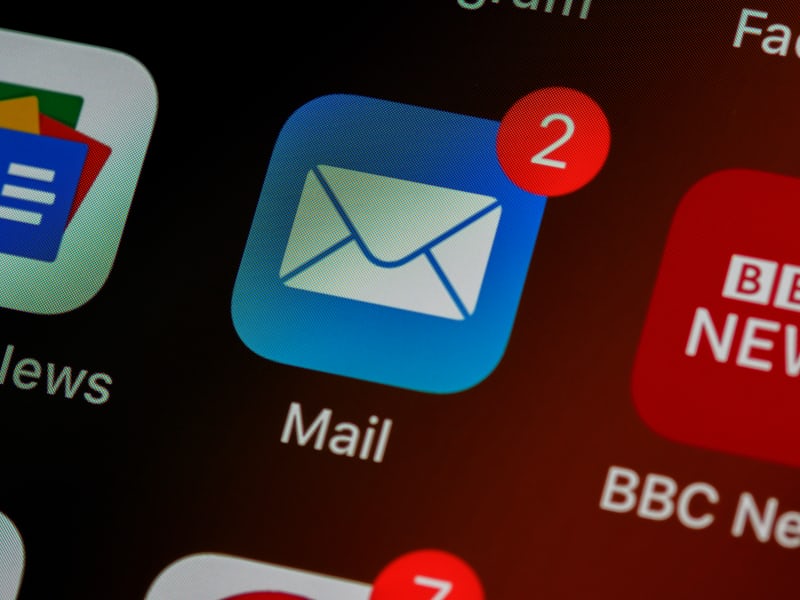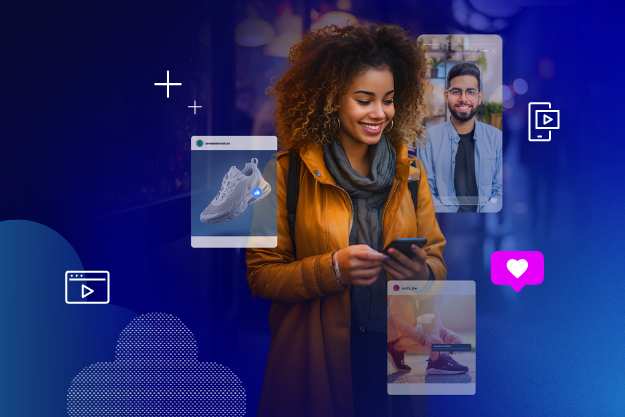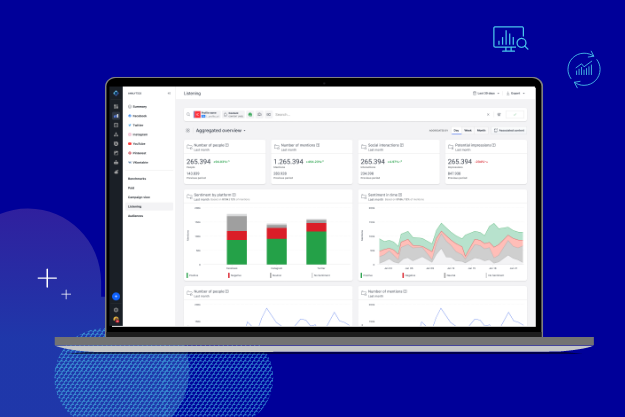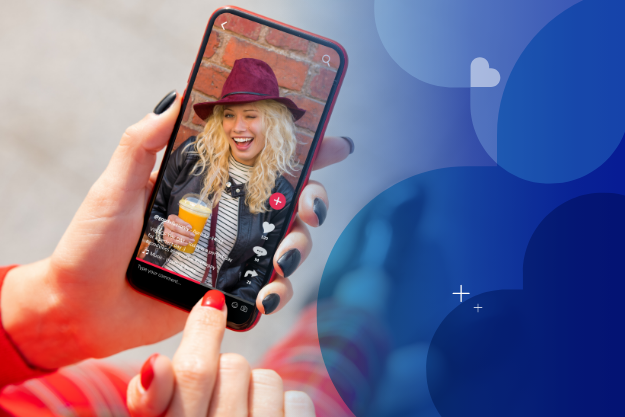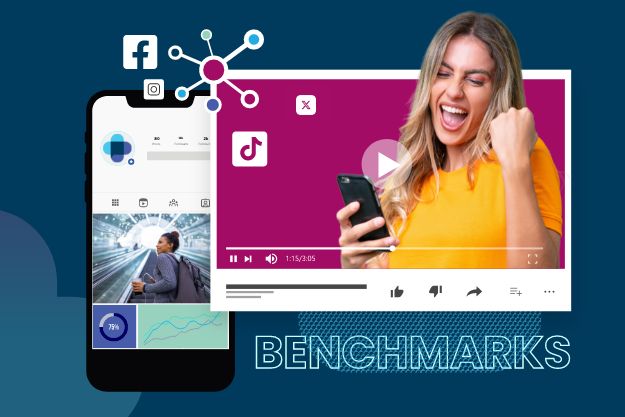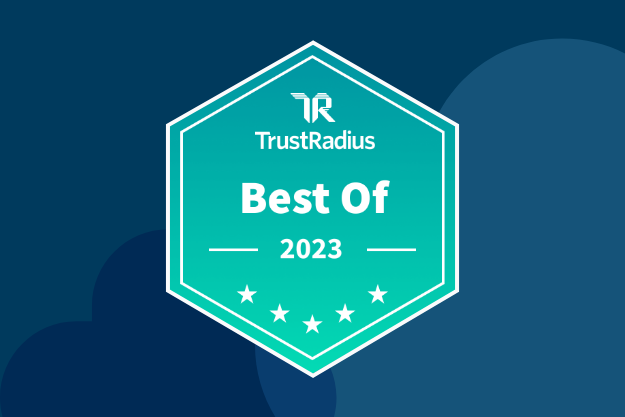One of the most profitable selling tools, email marketing offers a high-value connection between marketers and clients and will likely be relevant for decades to come. As of today, email still delivers the highest ROI for marketers, generating an average of 38$ for every 1$ spent, according to CampaignMonitor.
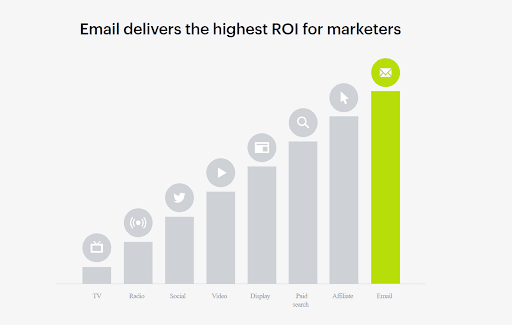
Your business can't afford to ignore email marketing and waste its potential. And what's more, you don't even need to rely on discounts or wait for special offers in order to sell with email marketing. Because when you forge solid relationships with your audience, they won't simply buy more often. They will support and defend your brand at all costs and recommend your products to their friends -- becoming free promoters in the process.
While many tricks for improving email conversion rely on heavy discounts and sales, some of the best email campaigns perform well because they're personalized and connect with their customers. What's more, by reducing your reliance on discounts, your email ROI will increase. Here are some ways brands are using their emails as a community-building channel.
1. Build trust with your audience by conveying brand value
81% of consumers need to trust a brand before buying from it. That's how important it is to build rapport with your email audience before even thinking about selling anything. Positioning your brand as an industry authority will make it easier for people to trust you and buy from you. To do this, send emails where you provide real value to your audience and become close to your prospects. Start building relationships with them and these potential customers will eventually feel inclined to buy from your brand.
Marketers often invoke ideas from Cialdini's rule of reciprocity, which explains that humans tend to return valuable favors given to them. And applying it is simple, you give something valuable for your audience (information, education, tools, gifts, etc) so they eventually return the favor by becoming a customer.
Emails that are perfect for this practice include:
Email newsletters.
Welcome email sequences.
Lead nurturing series.
New content announcements (such as new blogs, webinars, or videos).
Starbucks provides value in its email newsletters, which are often packed with coffee recipes you can try at home (while promoting its brand in the process).
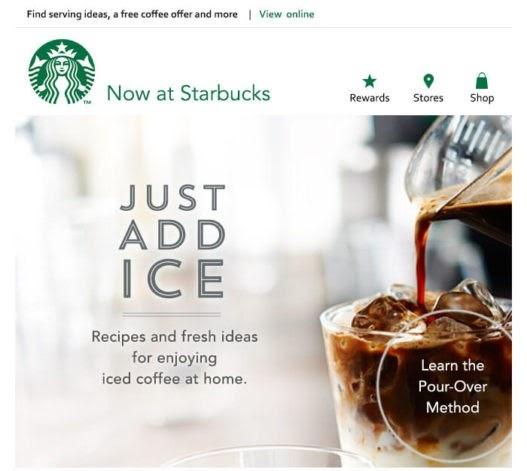
This works; If you know how to make good coffee, you know how good Starbucks is, and you'll feel more favorably toward buying from the brand.
2. Use user-generated content to improve relevancy
To stand out in your prospect's inbox, utilize more engaging methods like storytelling, customer reviews, and user-generated content. In short, you can sell more just by using the customer feedback you're getting for free, serving as proof that your brand is legit and that your products are good. This is a powerful way to leverage user-generated content. Plus, with email marketing, since your customers are already opted-in to communication, you've likely got a better understanding of who they are and which data categories they fall into. With this, you can use UGC to create broadly personalized emails that don't feel too personal.
Collecting user-generated content from your brand community is the first step – sharing that content across channels like email is the best way to uplevel your UGC game. For example, Kirkland's uses UGC from customers to promote its furniture and inspire potential customers with a gallery of authentic images. These images aren't only easy to come by, they also convert better. Kirkland's saw a fourteen percent increase in average order value after using UGC.
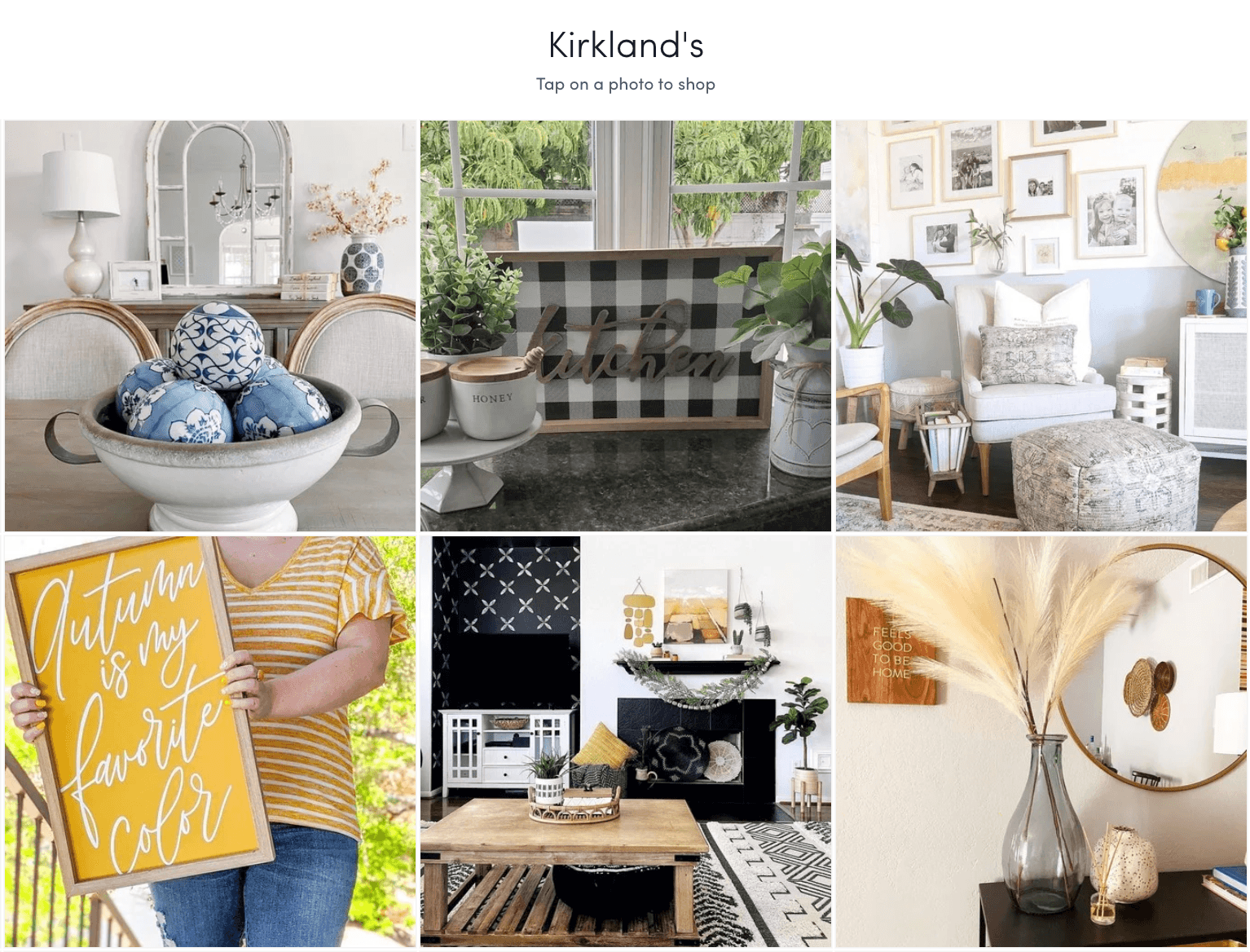
User-generated content is a proven way to improve your email marketing results. So if you want to increase your emails' CTR, there's no better time to begin implementing UGC.
3. Send warm welcome emails with customer reviews
There's nothing more welcoming than seeing other people making the same decisions as you, and achieving success. You can take advantage of this when people are brand new to your list. To make the most out of your welcome emails, it is critical to leverage your brand's first impression, and to do the following:
Showcase how your customers have been using your products.
Guide the viewer through the best content for them.
Teach them how to use your products.
A warm welcome will leave a nice first impression, and make it easier for new leads to believe in your brand and stick with you. Boll & Branch uses buyer testimonials to help new subscribers get a feel for their products and how other customers rate them, while indirectly promoting these products.
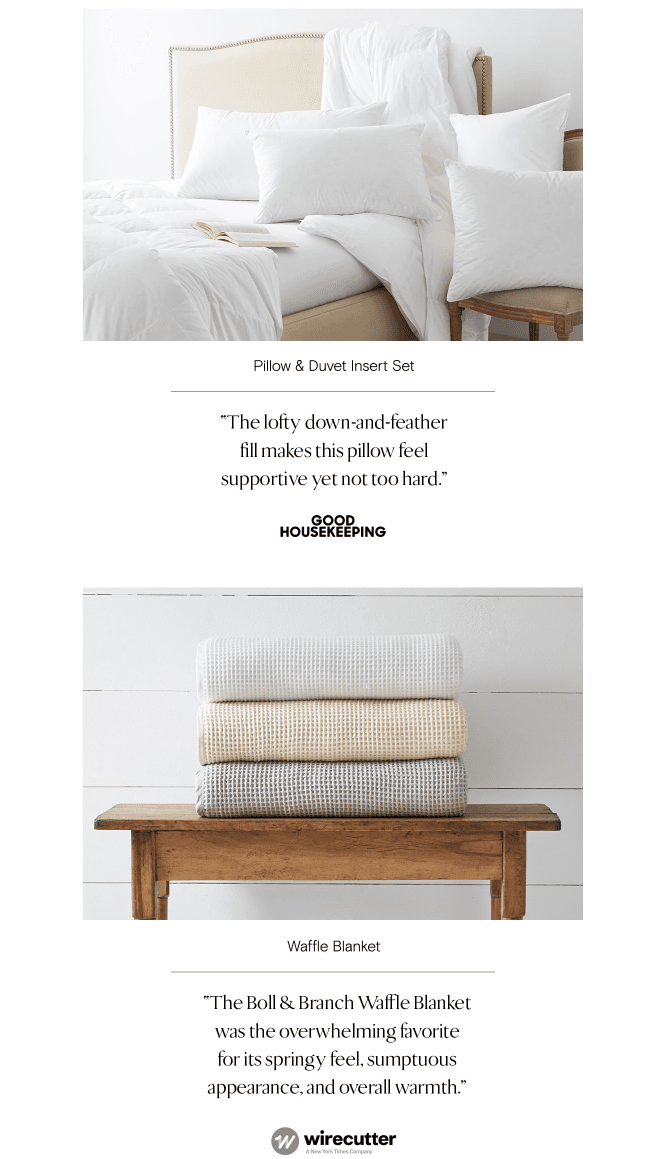
What's great about these testimonials is that you get educated about their products when you read them. When you begin showcasing customers who are excited about your products, it is just a matter of time until you get an army of brand promoters freely creating UGC for your marketing efforts.
4. Reengage subscribers by showing your brand values
It is known that email lists degrade by 22.5% every year due to subscribers changing their emails, becoming inactive, or simply because they unsubscribed.
Some of your subscribers are simply no longer engaged with your brand. Maybe because they only bought once, have technical problems with deliverability / check out / UX, or they forgot about your brand over time. The re-engagement campaign goal is to remind them how great your brand is, and why they should pay attention to you again.
Best practices for re-engagement campaigns include:
Showing how others are getting positive results from your products.
Providing exclusive content, support, or any irresistible offer.
Reminding the consumer of the last time they bought, and giving personalized recommendations and tips.
Some of the best re-engagement campaigns tease subscribers to revisit their website by giving them a limited-time coupon. OleHenriksen reminds its audience of its brand values without pushing consumers to make a purchase on the spot.
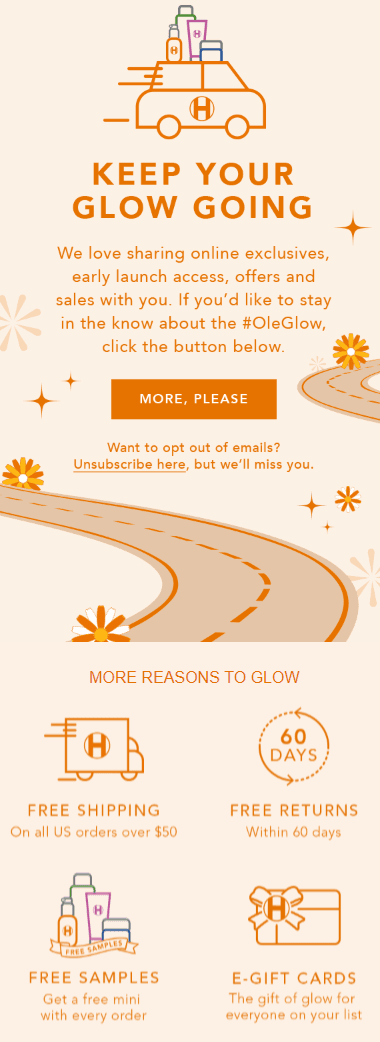
These types of emails make it easy for the reader to unsubscribe, which can sometimes be beneficial in cleaning up your brand's email list to maintain potential customers who may still have an interest in buying while weeding out those who do not.
5. Send personalized product recommendations
Product recommendation emails that are well-personalized bring more results than you think. According to BigCommerce, personalized product recommendations increase conversion rates by 150%, average order value by 50%, and overall revenue by 300%. This is only possible when you recommend products based on segmentation, browsing behavior, and specialized algorithms, which are not as complex as they seem. You can begin product personalization by identifying at least 5 different segments in your list based on previous responses and shopping behaviors. Then, create campaigns that are personalized for each segment.
The algorithm — depending on your email software — will then highlight the most relevant products in your promotional emails. Whether or not you already practice audience segmentation, this won't be rocket science for you.
Some of the best practices for product recommendations include:
Optimizing product recommendations for all devices
Including large, high-quality images for each product to make it more likely the recipient will click
Using a specialized algorithm for each user segment based on past behavior, ensuring the most relevant recommendations for your prospects
Avoiding overlapping emails, making sure that each prospect receives only one recommendation message
Including product recommendations in your cart abandonment emails
Hiding recommended product prices to maintain intrigue and curiosity, improving your CTR
Mastering personalization will position your brand as a trustful authority. If you don't adapt to personalization needs, your competitors will, and your business will stagnate. On the other hand, If you do adapt, you'll have a huge advantage over those who don't and your brand will have more bandwidth to thrive.
Email marketing will remain relevant for a long time. It has a low entry barrier and high ROI potential, so it is a safe bet for almost any business to invest in email. Providing your audience with valuable emails backed with testimonials and UGC holds a significant advantage over frequent, impersonal promos and discounts. Designing your brand's reimagined email campaign doesn't have to be difficult if you bear in mind some of these key concepts: customer experience, a welcoming approach, re-engagement, and personalized product recommendations. You don't need discounts to sell, and your brand will likely be more profitable without that typical email structure, so use these tips to begin reshaping your email marketing strategy today.
Kevin is a freelance SaaS copywriter and content creator. He helps digital brands create valuable content that connects right with their audiences, building sustainable and profitable long-term relationships with customers based on engagement and customer success. He loves to compose music and share his marketing thoughts on twitter.
Editor's Note: This article was originally published on pixlee.com. Any statistics or statements included in this article were current at the time of original publication.













